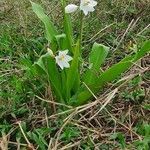Plants 20–50(–100) cm. high.. Rhizome short, irregular, often bearing fibrous remnants from previous years’ leaves; roots swollen, with robust dark tubers up to 7 cm. long distally.. Leaves rosulate, glabrous, lanceolate, 10–50 cm. long, 1–3(–6) cm. wide, sheathing below, apex acute to obtuse, sometimes cataphylls with ciliate margin.. Peduncle stout, 10–35 cm. long, leafless, glabrous, terete.. Inflorescence unbranched or rarely with a few basal branches, racemose, dense, up to 17 cm. long; floral bracts hyaline, lanceolate up to 15 mm.. Pedicels articulated in lower half to near the middle, up to 10 mm. long, 2–3 at the lower node.. Flowers large and showy, sweetly scented, shallowly bowl-shaped; tepals ± 20 mm. long and 6–9 mm. wide, 10–14-veined (the only species in the genus with more than 7-veined tepals).. Stamens shorter than the tepals; filaments filiform, 5–6 mm. long; anthers versatile, 3–6 mm. long.. Style straight, ± as long as the stamens.. Capsule deeply triquetrous, 15 mm. long, 8–12 mm. wide, slightly emarginate.. Seeds irregularly folded, 2 mm. in diameter.
More
A herb that keeps growing from year to year. It has a bulb or tubers. It grows 45 cm high and spreads 75 cm wide. The stems are slender and arch over. Small plantlets develop at the ends of the stems after flowering. The leaves are narrow and like grass. They have yellow and green stripes. The flowers are large and white.
Inflorescence developing before the leaves reach full size
Flowers large and ornamental













